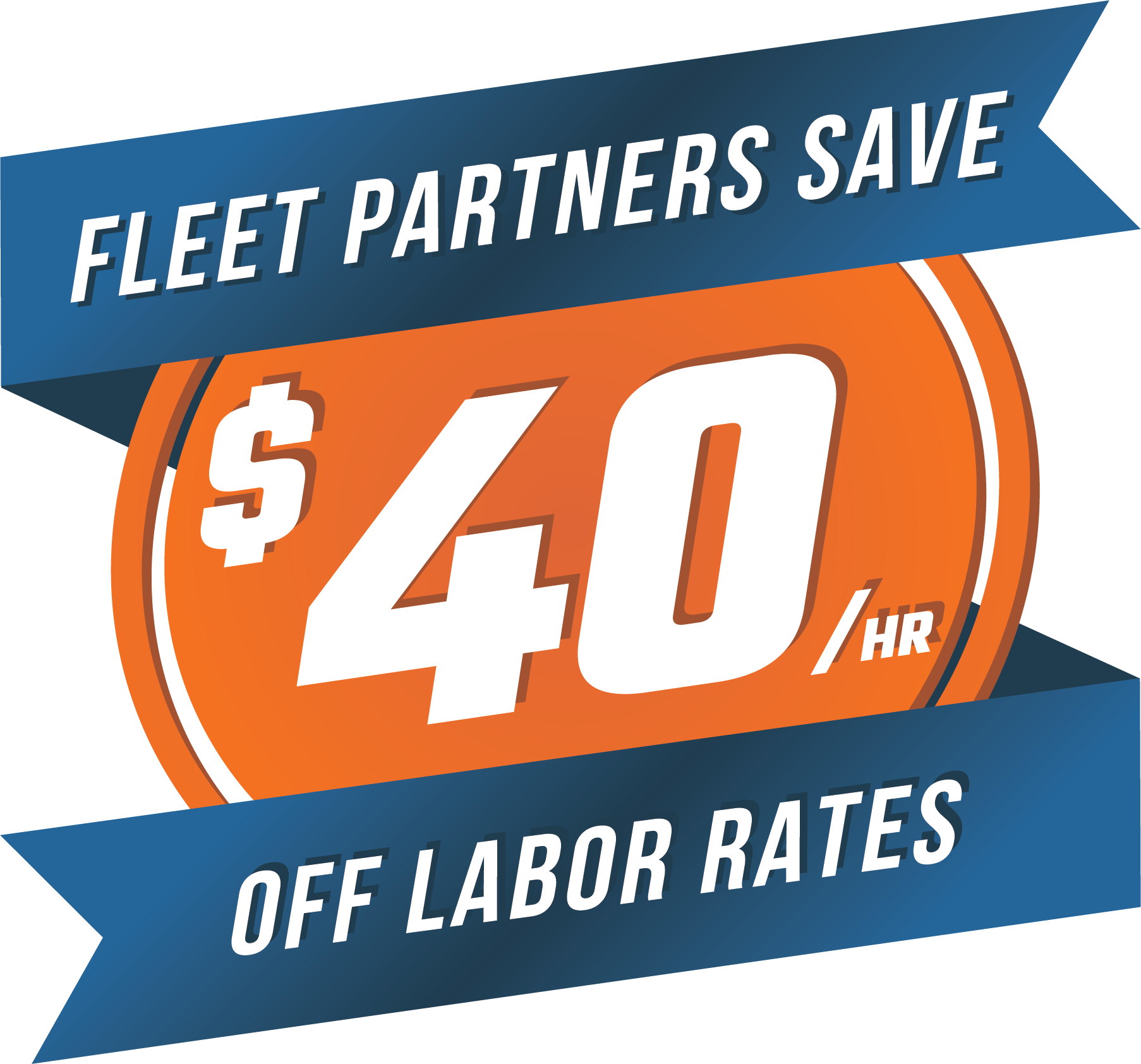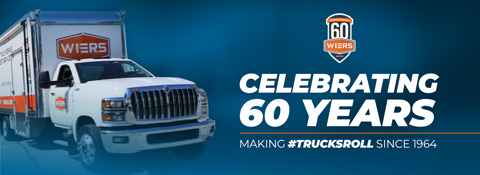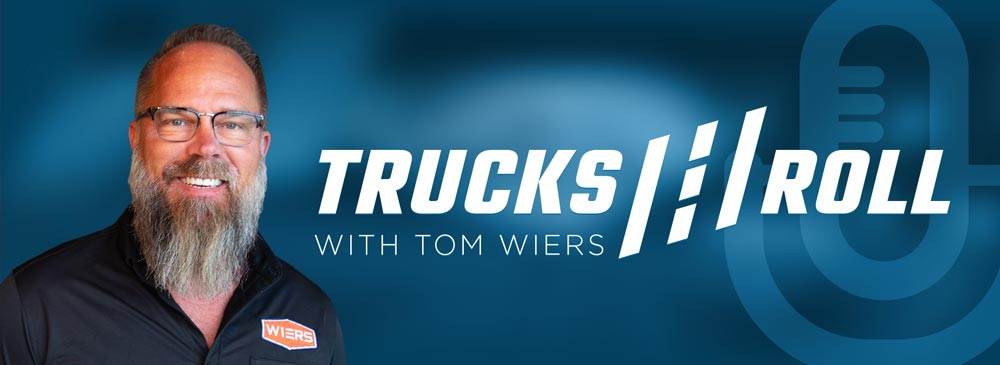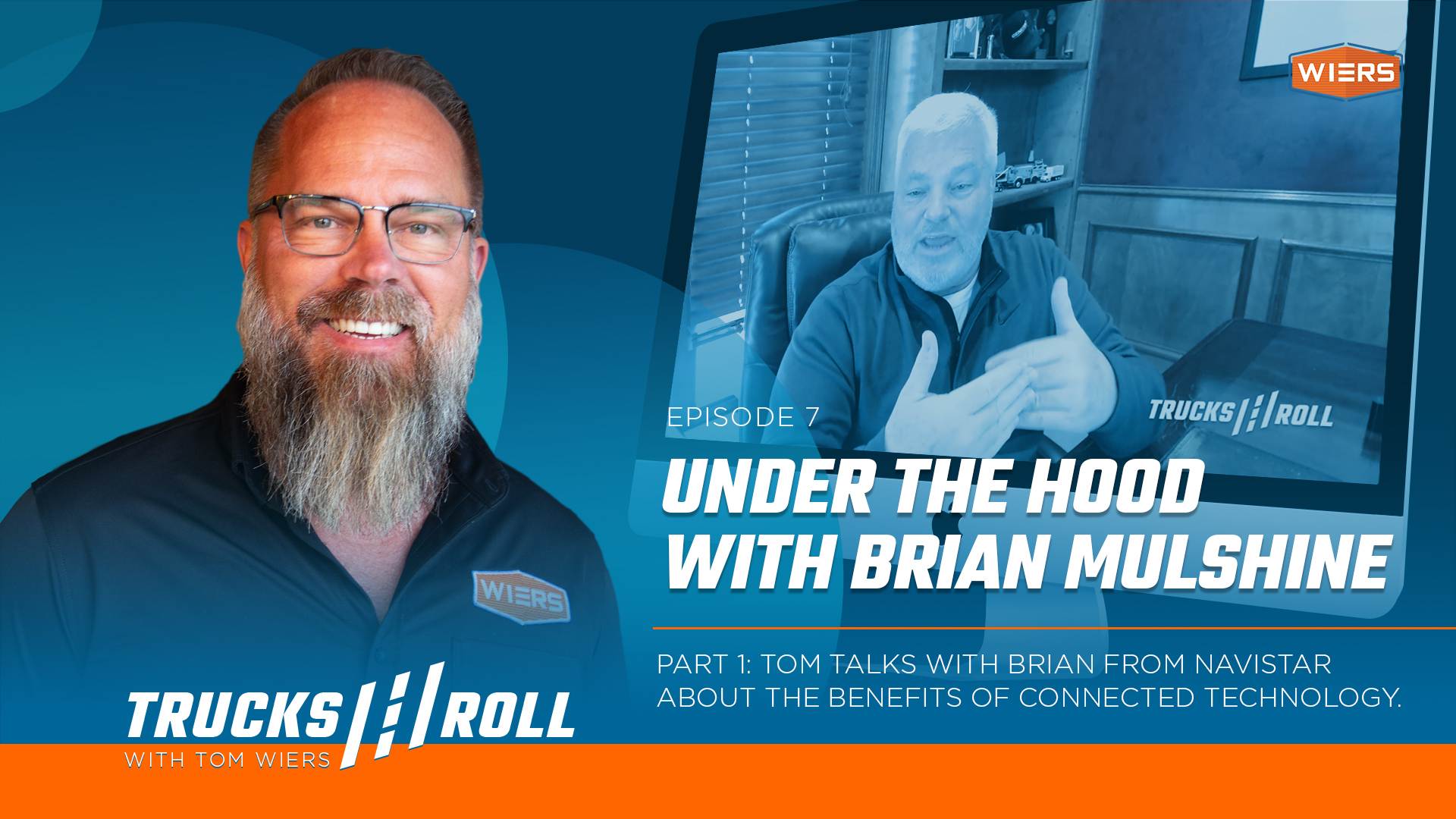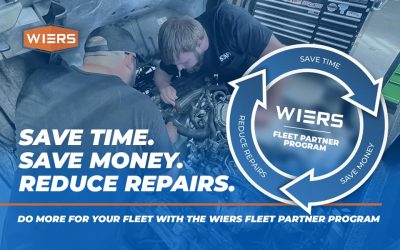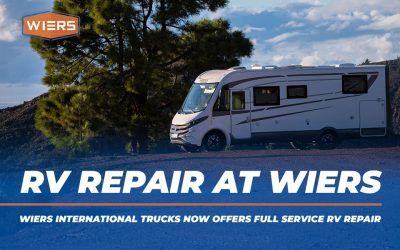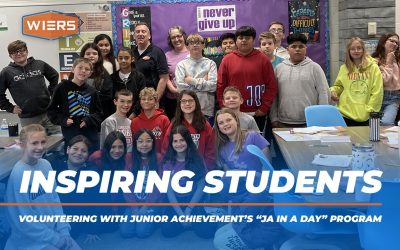
Under the Hood with Connected Technology – Trucks Roll Podcast Ep. 7
Part 1: Understanding the Benefits of Connected Vehicle Technology
Paving The Way With Navistar
In part 1 of our interview with Brian Mulshine from Navistar, we discuss the benefits of connected technology for diesel trucks. This episode will help you better understand some of the value of connected technology. From telematics to real-time diagnosis, new developments in technology is making it easier to keep your trucks on the road, improving your uptime.
We at Wiers are experts in this field and can help you keep your vehicles on the road and earning. Visit us at wiers.com today to learn more about our services and fleet partnership plans today!
What You’ll Learn
- How Brian’s unique role in the Navistar organization is helping fleets optimize their information.
- How better information helps inform better decisions and keeps your trucks on the road.
- Some of the history of how connected technology has evolved over the last few years.
Here is the transcript for Trucks Roll Ep. 7:
Brian: We now have over 30 different telematics solutions that we can ingest the information into our servers. So this way, when you’re working in a call center that a major customer or even a small customer, you can actually use your telematics device and not have to pay for another damn device to be broadcasting the same information.
Tom: Hi. Welcome to the Trucks Roll podcast with Tom Wiers. In this episode, we’re going to be talking to Brian Mulshine with Navistar. Brian is not only a longtime friend, but he’s an industry expert in connected vehicle technology and he’s participating in the digital transformation going on at Navistar with its customers. So I hope you enjoy this episode of Trucks Roll Podcast.
Hello everyone. Welcome to the Trucks Roll Podcast with Tom Wiers today. I’m delighted to have Brian Mulshine, a good friend of mine, and also he is the director of Digital Service Delivery for Navistar. Brian is probably one of the most knowledgeable, probably well-known guys in the industry dealing with servicing trucks, the networks, dealer networks, understanding fleet operations and what it takes to improve uptime and lower costs and those sorts of things. So it’s really a pleasure for Brian to take time out of his schedule to visit with us on Trucks Roll. And Brian, welcome. Appreciate you being part of this now.
Brian: I wouldn’t miss it for the world. Thanks, Tom. And like you said, we’ve been partners for a long time and I was excited to help and be a part of it.
Tom: Yeah, that’s that’s great. I you know, I just I always think about when I think about connected vehicle technology that’s kind of started off with the telematics devices. And we were Weir’s International up in northern Indiana… we were an early testbed for Navistar back when they used to have their engineering over at Fort Wayne. And I remember in the 2000 to 2003 time frame, installing the Aware, the Navistar Aware telematics devices in a customer’s fleet, doing a beta. And, you know, it was it was promising technology, but maybe a little bit ahead of its time. And so we’ve been dealing, you know, with this as a company for over almost 20 years. And I know you’ve been dealing with it for a terribly long time as well. So it’s fun to kind of reconnect and get a current state and maybe where things are going in the future. So let’s start off, if you don’t mind, Brian, just tell us about yourself, your career and you know, where did you grow up and where do you live and all those good things?
Brian: Wow, I’m a little bit of a mutt. Formerly, I was in the airline industry. My my father was even in the airline industry. We were born in New York, raised in Miami, and got hired by an airline. It was a cargo transport working for the military. And I worked all over the place, out of the country, in the country. And then after that, I met my wife in Chicago and she was down in Fort Lauderdale doing an internship for a hospital and ended up dating her. And I said, I got to find a way to get to Chicago. I figured in the airlines I could work anywhere. So I was excited. So started with the airline industry. I was an aircraft mechanic and the airline went bankrupt out of Chicago. And the lady doing my resume, her husband worked for International Trucks at that time and they asked me would I be interested in working on vehicles and working, taking mechanical engines out, put in electronic engines? And don’t blame me for that. That’s the case of the EPA. But they put the first engines in that were electronic and understood the data and understood what we’re doing. And from there a bit start with Navistar about 30 years this August I’ll be 30 years.
Tom: Wow. So what was that was the first was I remember the DT466 E that was that what we’re talking about here or is it the four that.
Brian: There was even with that it was the both of them came out about about the same time when the DT466. But that started the PLN, then we had the T 4 44 E years DT 466 E. So yeah.
Tom: So, so these are old guys talking, having shop talk here.
Brian: Yeah, yeah. It’s been a while.
Tom: Well those were good days because they were, they were easier than they are today. It seems that not quite as much complexity in our in our lives back then.
Brian: You’re exactly right. You’re exactly right.
Tom: So tell us about your current role at Navistar and what you guys are up to because you’re doing some amazing things and have always been a thought leader, you know, for the time I’ve known you and stuff. So what are you doing today?
Brian: Wow. And really my name, my title and just changed recently because it keeps on evolving and transforming. But now with digital today …everything is going digital and what I work on is the digital service delivery. And when I talk about that, I’m primarily focused. You know, one was telematics and now moved over strictly to focus on service delivery. We have a new product called International 360, which is our service communication layer that goes across our whole dealer network in the US, Canada and half of Mexico rolled out. We have all of Puerto Rico rolled out. It’s English, French and Spanish. It’s really exciting. But what we’re trying to do with digital data is we’re connecting the dealership’s fleet and dealer management system to 360 and then we connect it to the fleets with our own portal, or we connect to the backend of their own fleet management system. So everything is becoming transparent where customers today are creating thousands of repair orders per month, where the customer creates the repair order to the dealership and we’re reversing the flow of the information where the fleets are more engaged with a digital service transaction and getting updates rather than doing along with the old traditional phone calls. So I’ve been very focused there.
Tom: That’s. So is that. Is this… This could be interpreted that were they were asking the fleets to do the work of the dealers right. By creating your own ROs. But that’s not really what’s going on here. There’s a whole lot of additional value going on, right?
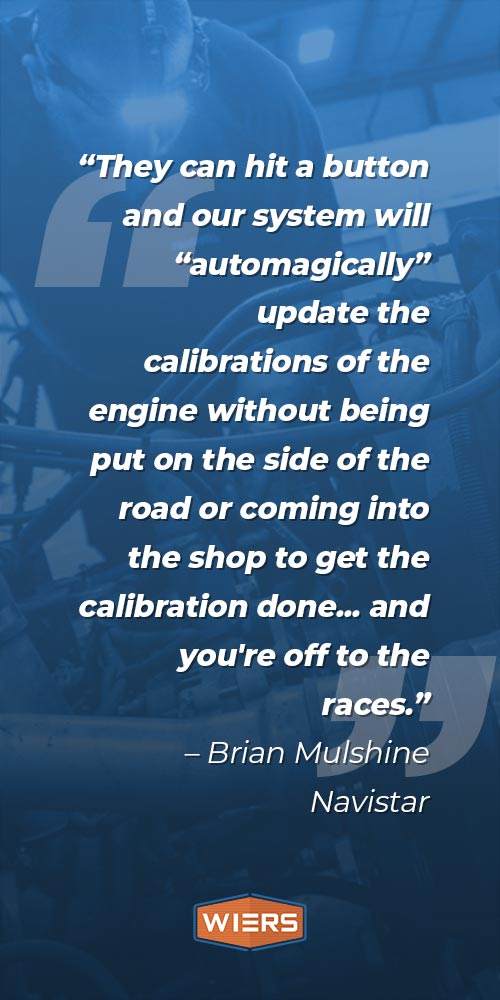
Brian: Oh, they’re incredible. You know, if you look at some of the larger fleet fleets that are out there, they have, you know, 10 to 20000 vehicles. You know, they have up to like 80 people in their call center throughout the 24 hours a day, seven days a week. Well, today they have to put that information in their fleet management system. And by hitting one button, it will actually transfer the information directly into 360 to the dealer and then it’ll connect you together right at the digital engagement, where the information is seamless and it helps a dealer because you’re aware of what’s coming. You have the faults remotely, and then the fleet doesn’t have to go into another damn system and type the data into the other system. It’s all coming from their native system.
Tom: And by doing that, you’ve got to be eliminating a tremendous amount, not only time you mentioned that, but errors, right? Because when somebody calls in, they transpire, they transpose information incorrectly. They don’t capture all the information. Right? So there’s going to be all kinds of savings associated with that.
Brian: Yeah. Some of the fleets we’re working with, you know, I think about Werner and J.B. Hunt and others, they have seen where they’ve had. They’ve gone from an average of 12 phone calls per service event on average now to 2 in some most, and many of them are zero. But the volume is like two calls. And instead of when they look at their number of trucks that are down across all brands, they really like going to the International network because it’s digital, they click and then the dealers are keeping the customer up to date. And also it just to set up a case into the dealer, it reduces their TAC time by 12 minutes per service order. So the fleets really are digging it really like and to be digital with us and we have a lot of big exciting things happening with more fleet management systems coming real soon.
Tom: You know, one of the things I’ve always respected about you and Navistar in this whole evolution of servicing and connected vehicle technologies, the stuff is the open platform.
Brian: That’s critical.
Tom: I’ve seen other manufacturers where they’re very it’s closed infrastructure or architecture, if you will, and you have to buy their product and use their their services as such. Yours has been your architecture has been different, you know, and I know you’ve been the brainchild behind most of all this. So why is that important and how is that differentiated Navistar and the Navistar dealers compared to the competing OEMs?
Brian: You know, it is really exciting because there are other OEMs where it requires you to start with their telematics box. If you’re talking about remote diagnostics, they can only do it on their own vehicles with their own box. But, you know, now sometimes the EPA doesn’t do everything really exciting, but this one is. They dictate what all codes must be broadcasted in a standard format that meets SAE. It’s an industry-standard, so you can read the information. You know, 100 dash one is low oil pressure on every engine out there. So having that data come off the telematics device in a standard format is critical. So years ago and working with the OCC team, we now have over 30 different telematics solutions that we can ingest the information into our server. So this way, when you’re working in a call center at a major customer or even a small customer, you can actually use your telematics device and not have to pay for another damn device to be broadcasting the same information. So it was one of those things that I was really excited about and I was kind of nervous at the same time because at that time our CEO was saying, “Hey, look, I think I can broadcast even the Freightliner, Volvos, Macs, etc..”
And I said, “But the problem is I’m going to have to put a dealer directory to tell them where to go because I can’t fix that other engine.” And he actually loved it. He said he brought a miracle on 34th Street. 31st Street is if we can’t if we can’t fix it, then tell him where to go. He says, I agree with that. Yeah. So I had support all the way from leadership that they said this is the right approach and not having a call center for a fleet happened to go to 15 different websites to find data to use one solution that has everything that’s outside.
Tom: Yeah, it’s really a value creation and you know, it’s for the customer and it also creates a lot of value for the dealers because if we go out and talk to a fleet, even if they’re, you know, maybe they don’t have they have zero internationals or very few internationals, we can still actually provide them a lot of value with the platform that you that Navistar has has designed and offered. And and it’s terribly cost-effective as well. So I just want to say thank you, because I think you guys have done a real service to the industry and to the customers and dealers and whatnot. So, well done there.
Brian: Thank you.
Tom: Tell me, I mean, you know, what is what is connected vehicle technologies? There’s a lot of terminologies out there, telematics and all these other things. You mentioned 360 and OCC, but what is connected vehicle technology today?
Brian: You know, when I look at this is the number of things that the OCC team is doing. It gets really exciting. Our On Command Connection, which is our telematics team that supports our dealers and customers. Now first is getting data off the vehicle and that’s that’s one element is great. You can get the health of the vehicle, the location, the speed and put it on a map. That’s great. But now with the number of vehicles out there and the number of times you have to update the calibration of the vehicle, you know, either International or Cummins, the fleet can have a dashboard and see which trucks are out of date and needs a calibration update. They can hit a button and our system will “automagically” update the calibrations of the engine without being put on the side of the road coming into the shop to get the calibration done. And we can also do the calibrations. We can do the parameters like reset road speed limiting, idle shutdown timers by you could set a template, put a profile together, apply it to 100 vehicles and you’re off to the races. You don’t have to down your fleet. That’s another solution. You know, when you look at it, we’re working on advanced features like remote vehicle unlock. We’ll be releasing late this year, early next year. We also have fuel analytics, fuel tax. We have the fuel analytics stuff. We also have tire pressure monitoring is another good one, fault of fleet help monitoring where it will give you a better summary of how your vehicles are doing in your fleet.
Tom: Right.
Brian: So we have a number of tools today that go above and beyond just looking at faults. You can actually manage your fleet better with better insights, and that will improve your uptime and drive your costs down.
Tom: Right. You know, and it’s easy for me to see these really large fleets. You mentioned 10,000, 20,000 vehicles or even if you have hundreds of vehicles, having somebody on staff dedicated toward this endeavor and really driving value and such. But what do you see in smaller fleets? I mean, Wiers Fleet Partners? Wiers International Trucks? We deal with large fleets, but we also deal with a lot of vocational applications where building materials and supply, you know, delivering products and services to the local market is is a big part of our customer base.
And, you know, if I’ve got ten trucks or I’ve got tow trucks or maybe I have two trucks, is this something I can apply in my business or because it is overwhelming, you know, just when I visit with you and hear all the capabilities, you know, sometimes my eyes roll back in my head and afterward we have to go grab some bourbon. But you know, what about the small guy? Can they use this? How do they use it? They use part of it? Can you talk to them about that, please?
Brian: Yeah, please. Your team, working with your team has been great because you have a dedicated team to support customers. And unlike other dealers, you’ve done a great job with your own call center and things that you’re doing managing fleets. So we’ve been building our tools for a small customer and you’re going to hear some great things out of the On Command Connection team this year that we’re going to have a new lighter I call mobile app that doesn’t have the complexity of a large On Command Connection portal. It’s really exciting what that team is doing. And then it integrates international 360 servers, communication, as well as the health of the vehicle into one simple mobile app. You’ll be seeing that real soon. So that’s one thing. The next thing is for some customers that really don’t want to deal with it, having a dealer like yourself and your uptime team, your uptime advocates where they can have the same tools but maybe have 20 or 30 customers that you’re going to keep an eye out for.
Tom: Right.
Brain: I’ve got your back type of strategy and able to help the customer decide when they need support. And that’s where our dealer channel is critical for the success of our customers. Having somebody to have their back.
Tom: Thanks, appreciate that. This reminds me of back in I think it was 2016. We’re doing some pilots with some customers and one was a moving and storage company. And they brought they brought their unit in on a Friday night, late Friday afternoon to one of our service centers. And there was a fault code. And our team looked at and said, you know, this truck needs to need some repair work. I wouldn’t drive it. The customer had a load go to Florida. They said, you know, I’m sorry, but but we need we need to get this load to Florida. On Sunday, what about 120 miles, ended up in Indianapolis near one of our other locations. And the truck broke down. And so we got a call on Monday morning. There was a tow bill involved. We got a rental truck and, you know, the customer was able to deliver the load, but it was proof positive that these codes that are coming off and the information of that that’s being shared by the vehicle can really lead to better decision making, less breakdowns and whatnot. And I just love that example because it’s…
Brain: Yeah.
Tom: So it was so tangible.
Brian: No, you’re right. And really the biggest challenge we have are people applying the data and using it properly. It’s hard, right?
Tom: Yeah.
You really need to. Have a team like you have done a dedicated team, but we’ve built some tools to where in on command connection you can put a geofence an invisible fence around your yard, and when the trucks come home every day, it actually has a monitor on your wall and you can see which trucks have a concern before they dispatch again,
Tom: Yeah,
Brian: …or it’ll send you instant weekly reporting or instant reports. I still go back. The best example I have, the number one item on a vehicle that causes a CSA violation is a headlight and our vehicles broadcast when your headlight is burnt out.
Tom: Yeah,
Brian: It’s a shame. I’ll go into a very large fleet and I’ll find 10-20 trucks with burnt-out headlights and then don’t even know it. And then they. The next question was, can you tell me when it burnt down? I said, Yeah, just click, click, and you’ll see when the fault started and they got excited because of a driver was trying to have them pay the bill and then realizing the drivers are not doing a pre-trip. So it’s really use the data, but you got to implement the process.
Tom: Yeah.
Tom: Hey, thanks for tuning in to this episode of Truck’s Roll Podcast. The next episode, we’re going to have Brian Mulshine back for part two. We’re going to talk about the future of connected technologies and also the changes going on at Navistar. In the meantime, if you need help with any sort of telematics device or connected technologies, please go to wiers.com and check out our offerings. We’re always willing to help you and advise you. And if you need help with maintenance or truck repair, we’re very good at that as well.
So wiers.com and we’ll talk to you soon.
Thanks.
Links:
- Share your thoughts and connect with us on Facebook
- Check out more videos on Youtube
- Listen to the Previous Episode
